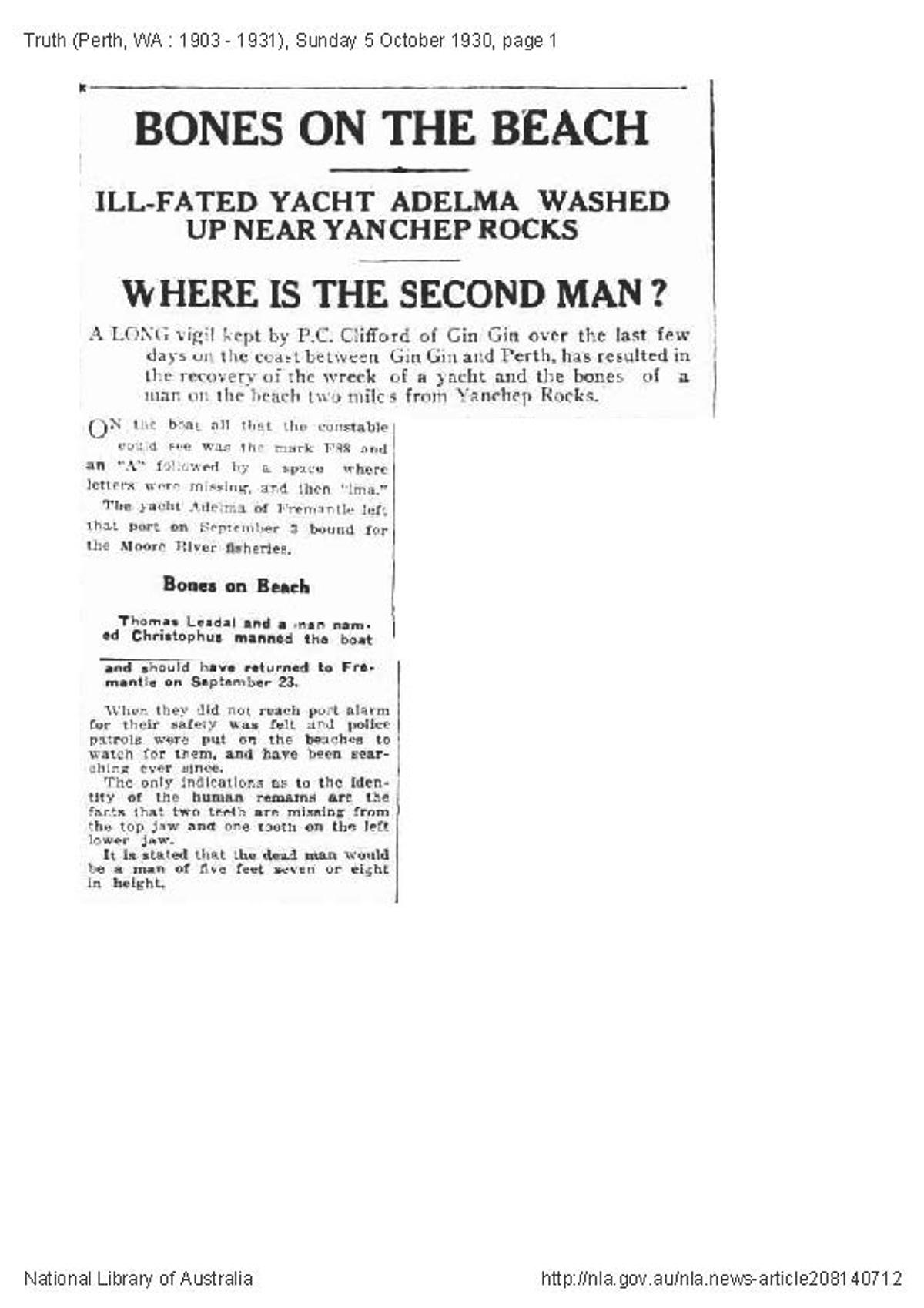Adelma
Vessel Name: Adelma
Thomas Liadel
Edmund Christoffersen
Drowned at Sea; Buried near Yanchep Beach
Died between 12 September and 3 October 1930

Newspapers covered the tragedy and police efforts to find the bodies.
The Adelma was a cruising and racing yacht, and was described as “well-rigged” and “a speedy craft” (Daily News, 6 December 1928: 2a), and “a good sea boat” (West Australian, 12 November 1930: 11f).
At that time it had been recently acquired by L. Vincent, who re-named it Pastime. Under this name it was on the register of three different yacht clubs, Royal Perth, Claremont and Freshwater Bay.
By November 1929, the yacht had reverted to the name Adelma, and was advertised for sale as a 24-ft comfortable fast cruiser. The contact address given in the advertisement was the Royal Perth Yacht Club.
During the winter of 1930, the Adelma was leased to two Swedish fishermen, Thomas Liadel (Leadal) (aged 31) of Arundel Street, and Edmund (Edward) Christoffersen (Christophersen) (aged 22) of Market Street, both of Fremantle. It then received a licence as a fishing boat (L.F. 88).
On 3 September 1930, the Adelma with the two Swedes on board, departed Fremantle. They intended to go fishing off the mouth of the Moore River, and had provisions for nine days.
Later that day they were seen by Paul Lovo, a fisherman in his boat off Cottesloe Beach, who stated that in his opinion, the mainsail carried by the Adelma was old and rotten. Four days after the fishermen sailed, heavy weather with strong westerly winds struck the area.
By 3 October, the men had not returned, and the police commenced investigations. Captain Fedran of the steamer, Gascoyne, said that on 4 October he had seen a half-submerged vessel some 10 miles north of Rottnest Island. This was at first considered to be the yacht, Rena, which had broken its mooring off Garden Island two days previously.
On the same day, Constable Clifford from the police station at Gingin found the skeleton of a man “from which the flesh appeared to have been eaten by sharks” (West Australian, 6 October 1930: 18f) on the beach at Yanchep.
Constable Clifford estimated the man to have been between 5 ft 6 in and 5 ft 8 in in height. There were two teeth missing from the front in the upper jaw and one from the left side of the lower jaw.
As the only clothing on the remains were a tan boot and portion of a sock on one foot, these features were considered important in possible identification of the victim. The constable buried the remains.
Also scattered along a length of two to three miles was the wreckage of a boat. An oar was found amongst the wreckage, bearing the brand “L.F. 88”, and a section of the planking was found to have the letters “LMA” and the number “88” on it.
On 9 October 1930, the manager of the Yanchep Estate, Robert H. Spiers, contacted the police to advise that one of his men had also found a body washed up on Yanchep Beach. It had no clothing, except a sock on one foot.
It was impossible to get a vehicle anywhere near the beach, and the condition of both bodies (which were lying 800 metres apart) made it impossible to carry them over sand hills and through the bush. Constable Chambers and a representative from Arthur Purslowe, undertakers, had managed to drive a van to only within five miles of the site.
Constable Chambers returned to the site where the bodies were found, bringing with him Doctor McKenzie. Under the orders of the coroner in Perth, Dr McKenzie did a post-mortem examination of both bodies, one of which Constable Clifford had buried on 4 October. The bodies were then buried where they lay.
A coroner’s inquest was held on 11 November by the deputy coroner, F.F. Horgan. He reached a verdict that Liadel and Christoffersen had died from drowning, resulting from the use of the old and rotten mainsail on the Adelma.
There is no record of anything being salvaged from the wreckage of the Adelma strewn along the beach, although the oar and section of marked planking were probably kept as evidence for the coroner.
At the opening of the 1930–31 Perth yachting season, a newspaper reported:
The club [Royal Perth Yacht Club] lost one boat, Adelma, which was lost during the winter while in use as a fishing boat, but although she was fast, she was seldom raced last year (Western Mail, 6 November 1930: 21).
